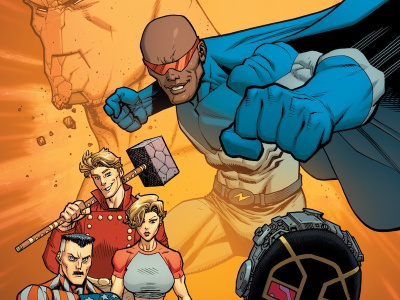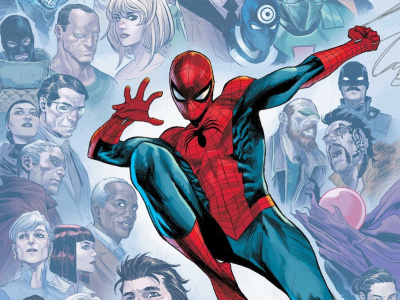We've earlier reported on the upcoming launch of Shonen Jump in the US (see 'Shonen Jump Lineup Tied to Cartoon Network'). We spoke to a group of the executives behind Shonen Jump to get the scoop on the business strategy behind the launch. In this first part of our two-part interview, we explore the distribution and marketing plans for Shonen Jump, including which channels will be used, how retailers will be supported, and how Cartoon Network is involved.
This interview, presented in two parts (for Part II, see 'Interview with Viz Management, Part II') was conducted at the San Diego Comic-Con International on August 2, 2002. Present for Viz were:
Seiji Horibuchi, CEO, President, and co-founder, Viz Communications, Inc.
Jason Thompson, Editor Shonen Jump, Viz Communications, Inc.
Rick Bauer, Vice President Sales and Marketing, Viz Communications Inc.
Torishima Kazuhiko, Senior Editorial Director, Shueisha Inc.
Satoru Fujii, CFO, Executive Vice President, and co-founder, Viz Communications, Inc.
We talked to the folks from Gutsoon about Raijin and asked them about their decision to go weekly (see 'Interview with Coamix Chairman Nobu Horie'). Shonen Jump is obviously a weekly title in Japan. Why was the decision made to go monthly here?
Horibuchi: Well it is, as you know, the comic distribution system. I think monthly is the only way to start it. We'd love to go to weekly publication if the market would support it, but I don't see anything happening right now. So we'd like to start with monthly, and see how the reaction is. We'll start with 260 pages or so, and before we go to bi-weekly or weekly we may add more titles into it, and then see how the support is, and then go to bi-weekly. I am thinking a year later or so we will be going to bi-weekly if we're getting enough response, and then hopefully it will be going to weekly. And one of our main distribution channels will be not through the traditional newsstand market or comic market. I am hoping that subscription will be our key distribution thrust.
Why do you think subscriptions will be more important than sales through retailers?
Horibuchi: Because of distribution. A weekly publication is extremely difficult. I don't know how the retailers could support it, or how the traditional distribution channels could support it, but subscriptions? We could do that.
So the reliance on subscription would be more for the conversion to weekly or bi-weekly? You see that as a necessary component for increasing the frequency?
Horibuchi: I think so.
What distribution channels are you starting out in?
Horibuchi: All.
Are you going to do newsstand?
Bauer: Yes, we're working on that right now.
Our goal for Shonen Jump here in the US is to make it a mass market magazine, so we're working with ProCirc, out of Florida; they're outsourcing our circulation. We're working with a gentleman who's the national newsstand manager of Readers Digest and going out and working at the wholesale level to let people know this magazine is coming, so we have high hopes for traditional newsstand, mass market distribution.
Are you buying any special displays in that channel?
Bauer: We're working on that right now. The launch is coming up in November and it's tight because of the holiday season, so we're going to take a look at whatever's available and pick it up if it makes sense. We're really looking to rely on our licensing partners, some of the other companies that have licensed these properties in different forms--card games, action figures--to work together on cross-promotions with tie-in and value-add, to really come out with a big bang in November with the magazine.
It's a great value, at $4.95 with 250 pages, but we also know that there are millions of Yu Gi Oh card fans out there, for example, and action figure fans so we're working together now collectively with some of our early advertisers in issue 0 to come up with the right promotion mix to make sure that the world knows that this magazine is out there in a big way in November.
You mentioned newsstands, what about bookstores?
Bauer: Absolutely.
Ingram, distributors, direct to chains?
Bauer: All of the above. We have some distribution relationships with Animerica right now. Primarily we can take this in three different phases. One is Diamond, with specialty comics direct. We're working heavily with Diamond right now to figure out what the right mix of point of purchase displays and signage is at the specialty comic store level. We're also going to make the book returnable for the first two months (see 'Viz To Make First Two Shonen Jump Issues Returnable') through the specialty comic retail so that everybody's encouraged to bring it in and to make it widely available. So we have specialty distribution through Diamond. We're also working direct with Musicland on some promotions. They're an Issue 0 partner for us. They're giving the book away free with purchase as well as putting it in with a poly-bag mailing of their Request magazine to raise awareness in that channel, and then, as I mentioned, the newsstand, so we have three points of distribution.
So is Musicland the only specialty retail chain, other than the book channel, that you'll be going at with that type of approach?
Bauer: We've got a lot of work to do, but we're in conversations with many people right now, directly. We've got a lot of excitement about the fact that in this book we have phenomenally popular titles like Dragon Ball Z and Yu Gi Oh, so it opens up a wealth of cross-merchandising and cross-promotional opportunities that are very important to specialty retailers
We have a Web relationship with Cartoon Network whereby they're going to be constructing an Adult Swim Reactor on the AdultSwim.com Website. Our content from Shonen Jump will be integrated into the AdultSwim.com Reactor. What that means is that you'll be able to access digital manga, the archived versions, as we go down the road so if, for example, you pick up the book in the third or the fourth month and you want to get up to speed with the back story, with a code in the magazine you'll be able to go to the Cartoon Network's AdultSwim.com and access the archives so you can quickly get up to speed with what's transpired with the first four editions.
There will also be some streaming anime with related properties. Right now what we've agreed to are thematic clips; so, for example, the best fight scenes between Goku and Piccolo would be available, things of that nature
What's yet to come (we haven't finalized it yet) will be full length streaming episodes of some popular titles, and once again you'd have to take the code from Shonen Jump to access that.
So in addition to our traditional newsstand, bookstore market, and specialty comics direct, we're providing that air cover with the Cartoon Network relationship. We think that all of that will serve to make the US aware that Shonen Jump is here and we look forward to the response.
What's the target demographic?







